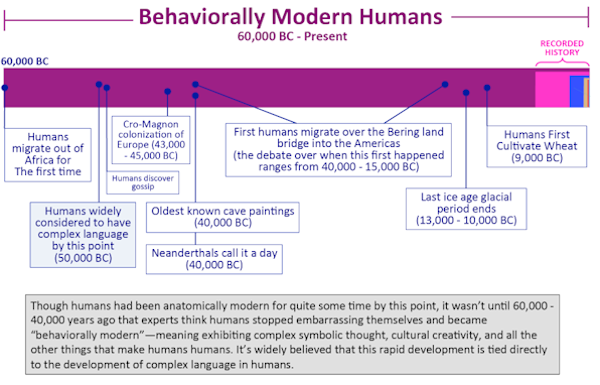The Evolution of Our Diet?
The following is my commentary, a reconstruction, written from my own notes, and may not be entirely as accurate as I (or Dr Noakes) would like. (I've added some text of my own in green.)
To make a proper assessment of what a human being should be eating it's important to know our history. Evolution is a very slow process unless some external forcing factor selects only some of a species, and eliminates the rest. The ice ages for instance restricted large land animals to a tiny part of the earth's surface near the sea. This has happened strongly, three times in the past, 180,000 years ago, 150,000 years ago and 20,000 years ago.
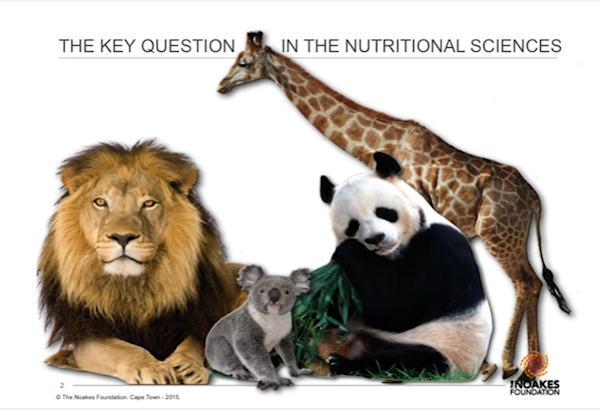 |
| Click to enlarge |
|---|
The adaptation of the human body is very slow. We are still best adapted to a diet we ate a 150,000 years ago. We are not adapted to the processed food that industry has provided only for the last 150 years. Understanding of our genetic evolution is crucial. Today we are eating a diet that's vastly different to the diet humans ate when Homo sapiens developed, and we can't expect there to be no consequences from that.
Many animals eat specialist diets. Why don't all mammals eat the same food? That's a key question. The giraffe, the cow, a panda bear, the lion and ourselves. The lion is a carnivore, and the cow a herbivore. Bears are usually carnivores, but the koala bear and the panda bear, have become herbivore. Giraffe's eat leaves, buds and branches high up in mimosa and acacia trees.
Dietary research is usually done with rabbits, mice or rats. Rabbits are herbivorous, mice are mainly herbivorous, while rats are omnivores and will consume almost anything. With such widely varied diets, what does it mean to talk about a "balanced diet" for mammals. Would a "balanced diet" for human beings, be more like the diet of a lion, or more like the diet of a cow?
The specialist diet for each, is indicated by the gut of the animal. Animals that eat only vegetable matter need to ferment their food, or allow bacteria to digest it for them. That requires a very large gut, and the animal spends most of the day feeding.
For instance, the giraffe eats only vegetable matter, and it has an enormous intestine, full of bacteria, which converts leaves into saturated fats, to provide the animal the nutriment it requires. Those bacteria are themselves adapted to the food in the local environment, and captured giraffe's may die when their food changes, because the bacteria in the intestine are not adapted to the new food source.
Human beings also have a very active population of bacteria in our gut, that are important to our health in ways that are still not understood. We can observe the giraffe in the wild, and see what food it eats. Giraffe's in a zoo usually suffer because they are fed pelleted food and hay, foods for which they are not adapted. Unlike the giraffe, most human beings also live in a zoo. We are fed a diet that is nothing like the diet of our natural environment.
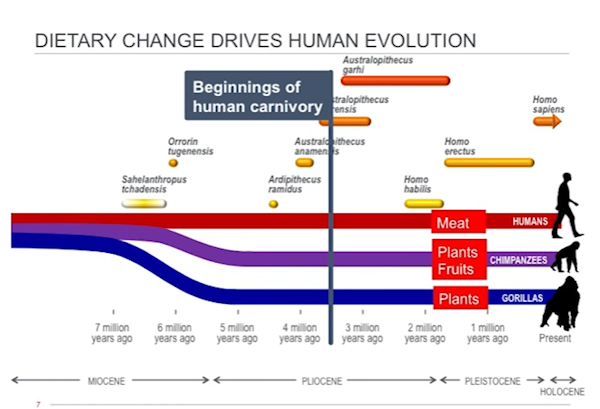 |
| Click to enlarge |
|---|
This table shows that seven million years ago humans, gorillas and chimpanzees had a common ancestry.
The gorilla is tall like us, but he only eats plants. He has a huge gut, a massive fermenting chamber, which converts cellulose plant material into saturated fats. Gorillas eat at least 12 hours a day. He has a proportionately smaller brain, but larger liver and larger digestive system as compared to human beings.
Chimps are much leaner. They eat more dense food, adding fruit to the diet. But still most of the day is needed for feeding.
Because humans eat meat, we can have a much smaller gut. We can say with confidence that the original human diet was sea-food, fish, turtles, crocodile, impala, rhinoceros and elephant. Humans are wonderfully adapted to be midday, high-sun hunters, they sweat easily and can run long distances in the sun. The animals they eat cannot. Eating this nutriment dense food allowed us to grow taller and to develop much larger brains.
All modern humans are survivors of hominin that survived this earlier ice age (150,000 years ago). At that time the sea was 100 meters lower than it is today. But it was very cold, so everyone lived in caves close to the sea in winter. Later people traveled the world, but only by creeping up the coast.
So like the Inuit today, we are best adapted to a diet high in fat, and fish is especially good for us all. For at least 20,000 years our ancestors were largely dependent of the sea for sustanance.
The development of Agriculture
Video Nine
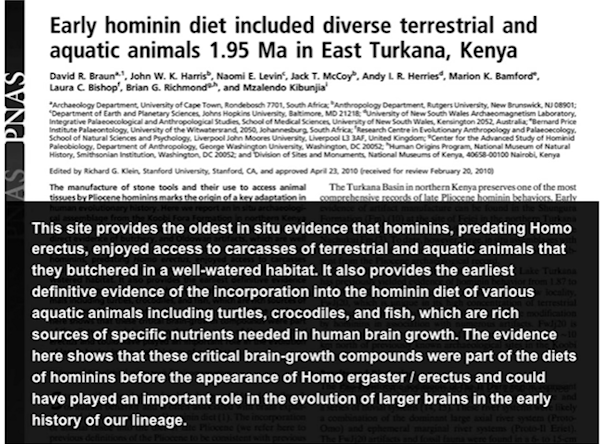 |
| Click to enlarge |
|---|
This paper explains that in Kenya, even earlier, 150,000 years ago, the diet of our pre-modern ancestors (Australopithecus africanus, found in four sites in southern Africa) included various aquatic animals, turtles, crocodiles and fish, and some butchered terrestrial animals. These ancestors were physically small, much smaller than modern humans, but more upright than chimpanzee. This ice age, was before the development of Homo erectus, and forced on the population a dietary change, to seafood, a dense nutrition that was needed for Homo erectus to develop. The increase body size, the upright stance and the growth of the brain are the result of better nutrition.
This dietary change, from being a herbivore to becoming a carnivore, is what created Homo sapiens. Modern humans only exist because of that change. They were later on, killing impala, rhinoceros and hippopotamus.
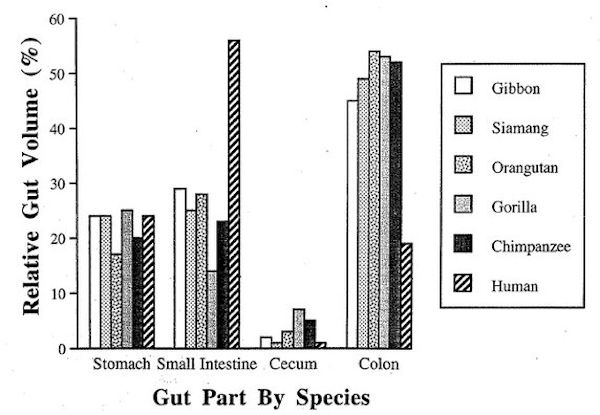 |
| Click to enlarge |
|---|
The brain size of Australopithecus africanus, represented by a skull known as ![]() Mrs Ples, has a brain capacity of about 485 cubic centimeters. After that brain sizes began to increase slowly over a million years, and more rapidly over the last 200,000 years.
Mrs Ples, has a brain capacity of about 485 cubic centimeters. After that brain sizes began to increase slowly over a million years, and more rapidly over the last 200,000 years.
This graph shows clearly that the human gut is quite unlike the guts of animals were are commonly compared with. The very large small intestine and the very small large intestine is the difference. In human beings the cecum is so short it's just part of the colon, and the colon is about one third of the length of the large intestine of herbivores. We eat much less plant material than herbivores, so our ability digest food by fermentation is poor (we get indigestion). We are not adapted to eating cellulose foods; unless they are cooked. We are well adapted to eating meat and fat.
It had previously been thought that the key change in human behaviour occurred 100,000 years later. At the time of the last ice age. But clearly in this earlier hominin population we already have the use of tools for hunting and the use of pigments for decoration and the ability to adapt to a hostile environment.
The discovery was made by Institute of Human Origins at Arizona State University, in a cave at Pinnacle Point near Mossel Bay, on the southern coast of South Africa, about 200 miles east of Cape Town, and reported in 2007.
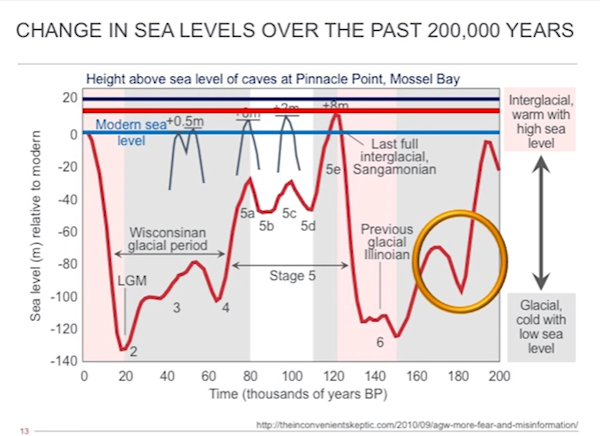 |
| Click to enlarge |
|---|
200,000 years ago the sea level was close to what it is today, and then suddenly, over period of only 50,000 years the sea level dropped 120 metres, as an ice age occurred. Researchers concluded, that forced onto the coast by the cold, a small population, maybe as few as 600 couples, may have found that eating shellfish was the key to survival, at least in winter. These cooler and drier conditions that had prevailed for thousands of years in the interior of Africa. Australopithecus africanus, was forced to the coast, and forced to relinquish a diet of fruit, plants, nuts, seeds, roots, insects, and eggs, which were only available in the short "summer."
 |
| Click to enlarge |
|---|
The only reliable food source was the sea. Those who could eat fish and shellfish, survived. Those who were unable to do so vanished. Arizona State University, team leader, Curtis W. Marean, said that a small population of cave-dwelling modern humans struggled and survived through the prevailing cold, eating shellfish and developing somewhat advanced technologies. This was the case for 20,000 years, when the population was almost entirely dependent on seafood for part of the year.
“It is possible,” he concluded, “that this population could be the progenitor population for all modern humans.”
Researchers tell the journal Nature the remains were buried in sediments, about half-a-metre deep, that are 164,000 years old, cemented to the wall of a cave. "All we find is the trash that was left behind, so we have to interpret what they were doing from the remains," said team member Erin Thompson.
Curtis W. Marean, the team leader and a paleoanthropologist with the Institute of Human Origins at Arizona State University, said, “Shellfish was one of the last additions to the human diet before domesticated plants and animals were introduced,” more than 10,000 years ago.
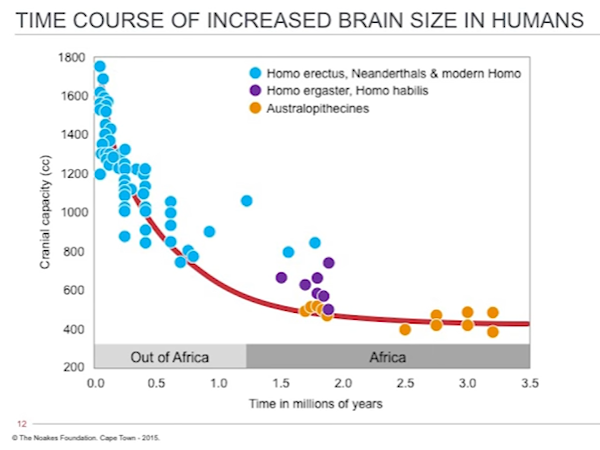 |
| Click to enlarge |
|---|
In an accompanying article, Sally McBrearty of the University of Connecticut and Chris Stringer of the Natural History Museum in London, who were not involved in the research, said the find provided “strong evidence that early hominin displayed key elements of modern behavior” as early as 164,000 years ago.
"There is some potential ochre use earlier than this but Pinnacle Point is much the best context. There is a lot of red ochre and the colour is very striking," commented Professor Chris Stringer, of London's Natural History Museum, who was not connected with the research team. "Even if some of it might be having a functional purpose, with that amount and the fact they are selecting this particular colour must have symbolic significance, we think."
 |
| Click to enlarge |
|---|
Palaeoanthropologist Professor Curtis Marean said: "We also found what archaeologists call 'bladelets' - little blades less than 10mm in width, about the size of your little finger. "These could be attached to the end of a stick to form a point for a spear, or lined up like barbs on a dart - which shows they were already using complex compound tools."
This seems to explain why Homo sapiens has teeth like a herbivore, and yet eats the diet of a carnivore. The precursor to Homo-sapiens was forced to eat seafood, almost nothing else by seafood, for much of the year, every year for at least 20,000 years. This food dense rich diet, promoted the development of a new species, Homo sapiens, and explains why our natural diet is more like that of the lion than the chimpanzee.
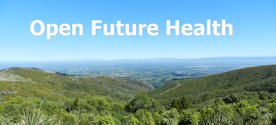 Out of Africa - Prehistoric Human Evolution (1)
Out of Africa - Prehistoric Human Evolution (1)